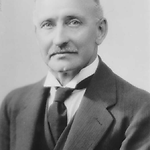Person
Kershaw, James Andrew (1866 - 1946)

Kershaw, James Andrew Portrait
Details
- Born
- 13 April 1866
Fitzroy, Victoria, Australia - Died
- 16 February 1946
Windsor, Victoria, Australia - Occupation
- Zoologist and Museum curator
Summary
James Kershaw joined the National Museum, Melbourne in 1883 as an assistant taxidermist to his father William Kershaw. Over the next 48 years James Kershaw rose through the ranks to become museum Director (1929). Although Kershaw officially retired in 1931, he was appointed the museum's first honorary curator of Zoology. James Kershaw joined the Royal Society of Victoria in 1900 and held many positions within the Society. He was President from 1918-1919.
Details
Chronology
- 1 October 1883 - June 1890
- Career position - Assistant Taxidermist at the National Museum in Melbourne
- 1888 - ?
- Career position - Member then President of the Field Naturalists' Club Victoria
- July 1890
- Career position - Taxidermist at the National Museum
- c. 1899
- Career position - Curator of the Zoological Collection at the National Museum
- 1900
- Career position - Member, Royal Society of Victoria
- 1908
- Career position - Royal Australasian Ornathologist's Union expedition to Bass Strait
- 1908 - 1946
- Career position - Honorary Secretary, Wilson's Promontory National Park Committee of Management, Victoria
- 1909
- Career position - Expedition to Bass Strait
- 1911
- Career position - Platypus studies at Hopkins River in Victoria
- 1913
- Career position - Expedition to the Barrier Reef, Queensland
- 1918
- Career position - President, Royal Society of Victoria
- 1920 - 1923
- Career position - Honorary Secretary, Royal Society of Victoria
- 1921
- Career position - Expedition to Ooldea, Western Australia
- 1922
- Career position - Trustee, Royal Society of Victoria
- 1924 - 1925
- Career position - Honorary Librarian, Royal Society of Victoria
- 1928 - 1931
- Career position - Director of the National Museum of Victoria
- 1931
- Life event - Retired and appointed Honorary Curator of Zoology at the National Museum
Related entries
Archival resources
Adolph Basser Library, Australian Academy of Science
- Australian Botanists - Biographies, MS 064; Adolph Basser Library, Australian Academy of Science. Details
Mitchell and Dixson Libraries Manuscripts Collection, State Library of New South Wales
- Baldwin Spencer - Records, 1880 - 1929, ML MSS 29; Mitchell and Dixson Libraries Manuscripts Collection, State Library of New South Wales. Details
Published resources
Book Sections
- Pescott, R. T. M., 'Kershaw, James Andrew (1866-1946), scientist' in Australian dictionary of biography, volume 9: 1891 - 1939 Gil-Las, Bede Nairn and Geoffrey Serle, eds (Melbourne: Melbourne University Press, 1983), pp. 578-579. http://www.adb.online.anu.edu.au/biogs/A090579b.htm. Details
Journal Articles
- K., R. A., 'The late J. A. Kershaw', Victorian naturalist, 62 (1946), 243-4. Details
- Kershaw, Jas. A., 'John Leadbeater of the National Museum', Victorian naturalist, 61 (1) (1944), 23. Details
Resources
- Wikidata, http://www.wikidata.org/entity/Q21388386. Details
- 'Kershaw, James Andrew (1866-1946)', Trove, National Library of Australia, 2009, https://nla.gov.au/nla.party-1468861. Details
See also
- Black, J. Hope, 'The Kershaw Dynasty', The Victorian naturalist, 122 (2005), 351-7. Details
Digital resources
McCarthy, G.J.
Created: 20 October 1993, Last modified: 26 February 2018
- Foundation Supporter - Royal Society of Victoria
